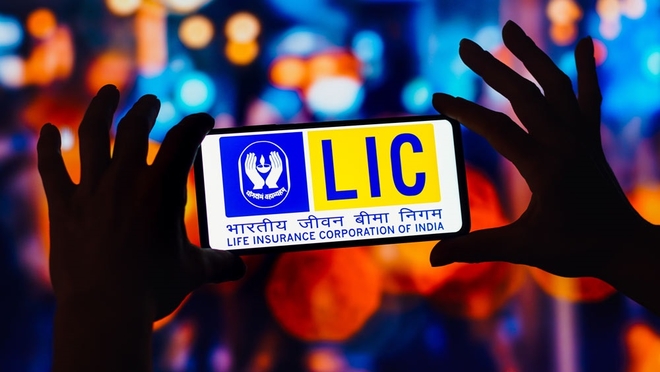
Zindagi ke sath bhi, zindaagi ke baad bhi. The iconic tagline of Life Insurance Corporation of India (LIC) embodies the nostalgia of pre-liberalisation India. In fact, before the 90s, life insurance in India meant LIC, as the sector was exclusive to public players. Even after the sector opened in the 90s, LIC held a near-monopoly for a decade.
However, recent data suggest the PSU behemoth is losing market share to private players, such as HDFC Life , ICICI Prudential Life , and SBI Life .
Market share on the basis of new premiums written
Private insurers are on a steady rise while LIC's market share declines
| Company | Nov-23 | Nov-22 | Nov-21 | Nov-20 | Nov-19 |
|---|---|---|---|---|---|
| LIC | 58.8 | 67.8 | 63.4 | 69.4 | 71 |
| HDFC life | 8.3 | 6.5 | 7.9 | 7 | 6.4 |
| ICICI Prudential | 4.7 | 4.1 | 4.9 | 3.9 | 4.2 |
| SBI | 10.1 | 7.3 | 8.8 | 7.3 | 6.3 |
| Source: IRDAI | |||||
In addition, the growth of private players has been profitable. Their value of new business (VNB), which gauges potential profits from new policies, has witnessed double-digit annual growth in the past five years. Furthermore, their embedded value (EV), a metric representing the present value of all expected future profits, has witnessed consistent growth in the same period.
Value of new business (VNB) of private insurers
| Company | 2023 | 2022 | 2021 | 2020 | 2019 | CAGR |
|---|---|---|---|---|---|---|
| HDFC | 3674 | 2675 | 2185 | 1919 | 1537 | 24.3% |
| ICICI Prudential | 2765 | 2163 | 1621 | 1605 | 1328 | 20.1 |
| SBI | 5067 | 3704 | 2334 | 2012 | 1719 | 31% |
Embedded value (EV) of private insurers
| Company | 2023 | 2022 | 2021 | 2020 | 2019 | CAGR |
|---|---|---|---|---|---|---|
| HDFC | 39527 | 30048 | 26617 | 20650 | 18301 | 21.2% |
| ICICI Prudential | 35634 | 31625 | 21906 | 23030 | 21623 | 13.3% |
| SBI | 46044 | 39625 | 33386 | 26291 | 23728 | 18% |
So, what strategies did the private players employ to turn the tide in their favour? Let's have a look.
Innovative products
LIC shares a common challenge with many PSUs—it tends to lag in adopting new technologies and fostering innovation. Private insurers capitalised on this weakness, focusing on introducing innovative products and enhancing customer satisfaction.
A prime example of the above would be SBI Life Insurance's ULIP Smart Shield, an innovative product allowing policyholders to invest in a wide array of funds alongside their life insurance coverage. In contrast, LIC's approach to integrating life insurance and investing has been limited to traditional ULIPs.
Chucking out the middleman
Customers favour a one-stop-shop for their financial requirements. For instance, someone banking with SBI for decades is likely to choose SBI Life Insurance for their life coverage rather than opting for LIC.

Private players played to this consumer preference and pushed insurance policies through bancassurance channels. In simple terms, they started selling insurance policies through banks. According to CRISIL, the share of the policies sold through bancassurance channels in the total new policies sold grew from 15 per cent in FY12 to 32 per cent in FY22.
This strategy yielded a dual advantage. First, it gave private insurance access to the vast consumer pools of banks. Second, it improved cost-effectiveness as selling through bancassurance channels allowed them to sell policies without insurance agents.
Taking the digital route
Selling insurance through digital routes has been a huge contributor to the accelerated growth of private insurers. Apart from enhancing ease of access, selling policies through digital routes, such as aggregator apps, allows insurers to bypass insurance agents and sell policies directly to consumers. Also, aggregator platforms allow comparing policies of different companies, fast-tracking decision-making for consumers.
The data also suggests that consumers prefer buying insurance digitally. According to CRISIL, the share of digital transactions in terms of total volume of life insurance policies has increased from 39 per cent in FY15 to 75 per cent in FY22.
In contrast, LIC entered the digital arena relatively late, commencing digital policy sales in FY21. Currently, digitally sold policies by LIC constitute a minimal share of the total policies sold.
Investors' corner
Investors can rejoice in the fact that the opportunity size of the insurance sector is immense. While the present growth is promising, the overall sector remains highly underpenetrated compared to global standards. As per SBI Life's annual report, life insurance accounted for only 3.2 per cent of the total GDP in FY22.
However, the competitive intensity in the private space is intense. Also, investors should note that the life insurance industry is often among the worst-hit sectors in events similar to the pandemic. Furthermore, in the financial services space, the insurance industry is severely impacted during economic downturns.
It is also important to note that we are not stating that private players are better investments than LIC. The PSU insurer continues to be the market leader in the industry. Do the due diligence before investing.
Also read: How to analyse life insurance companies








